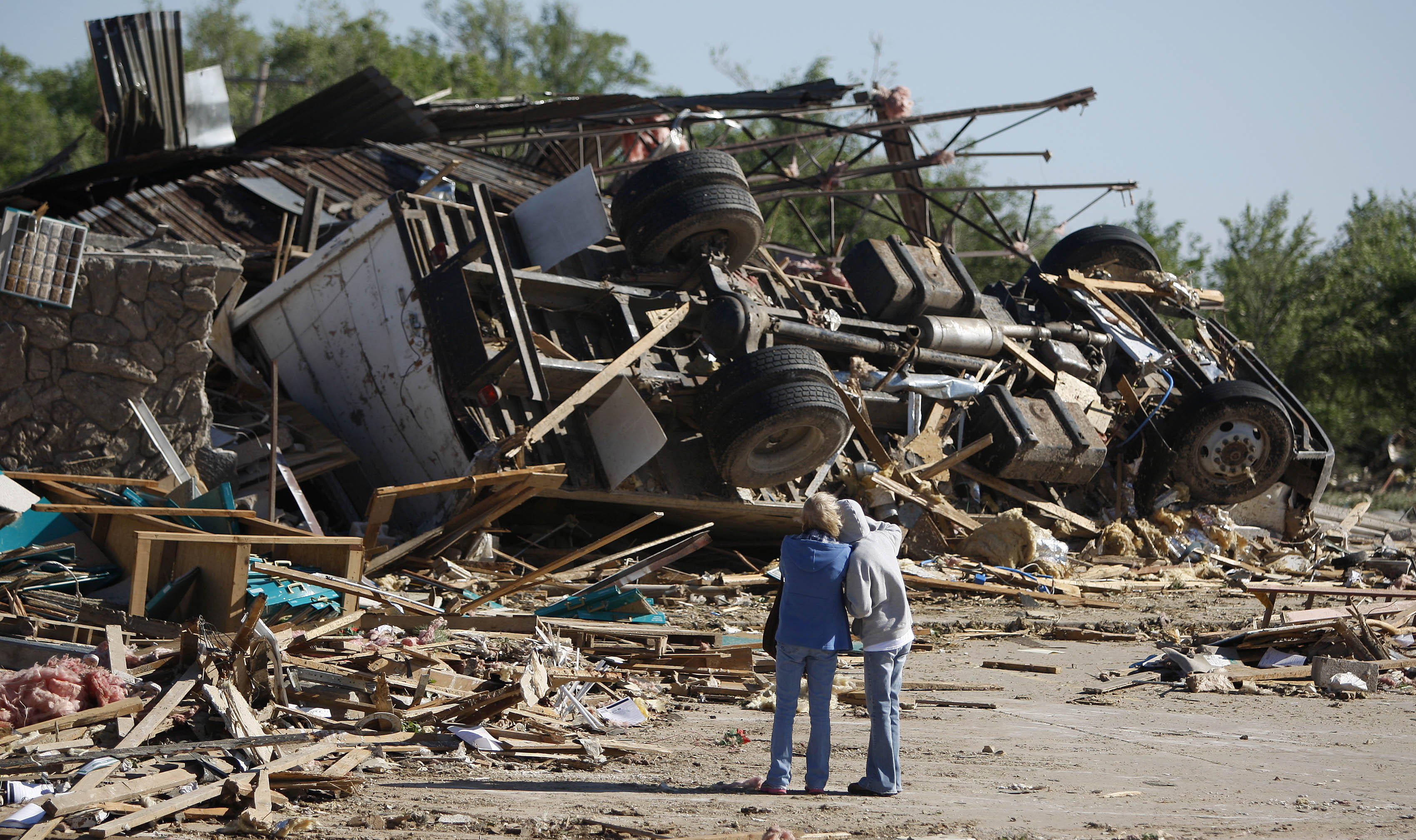Oklahoma is a major fuel and food producing state in the southwestern part of the United States. Thousands of oil and natural gas wells dot the Oklahoma landscape. Millions of white-faced beef cattle graze on Oklahoma’s flat plains and low hills. Fertile fields produce vast crops of wheat.
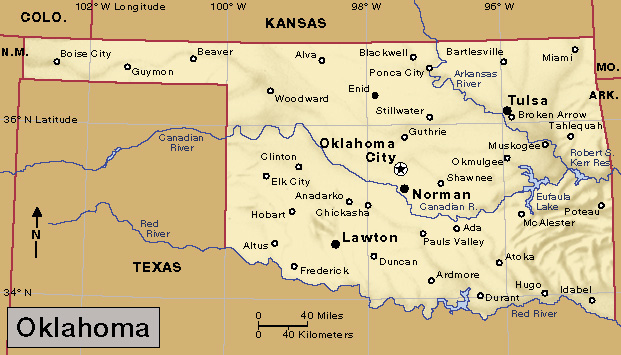
Service industries and manufacturing are also important in Oklahoma. The state’s location midway between the east and west coasts makes it an important transportation, communication, and distribution center. Oklahoma’s manufacturing plants turn out large amounts of aerospace equipment, food products, machinery, refined petroleum, and tires.
The development of Oklahoma’s vast natural resources began with the Indigenous (native) Americans, also known as Native Americans. In the 1800’s, the United States government made most of the Oklahoma region a huge reservation for Indigenous people. This reservation was called the Indian Territory. Vast numbers of Indigenous people, then called Indians, had been forcibly moved there from their ancestral homelands in the southeastern United States. They established separate nations, with their own governments and their own schools. The name Oklahoma is a combination of two Choctaw words—okla, meaning people, and homma, meaning red.
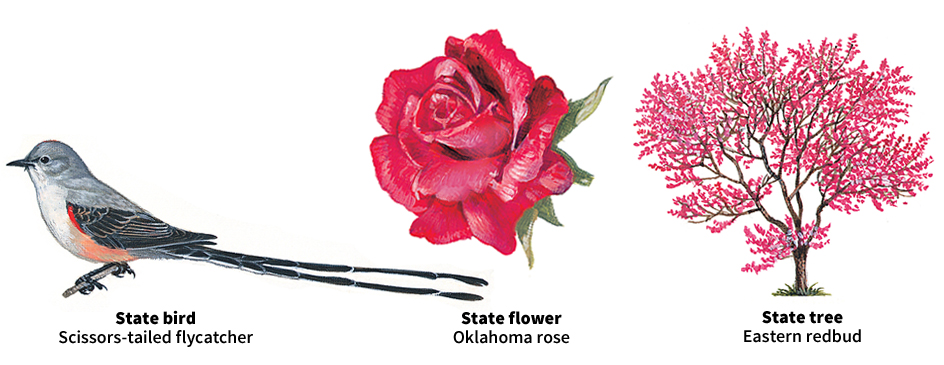
The government first opened Oklahoma to white settlement during the late 1880’s. Oklahoma became known as the Sooner State because some settlers were there “sooner” than the land was opened. It is also called the Boomer State, after the promoters who “boomed” white settlement. The land was settled rapidly, and white newcomers soon far outnumbered Indigenous Americans.
During the early 1900’s, the farms and ranches of Oklahoma were fertile and productive. In the 1920’s, however, unsustainable farming practices led to severe soil erosion in many parts of the state. In the 1930’s, a long dry period and low farm prices brought disaster to the farmers. Large numbers of farmers and other workers left the state, and the population of Oklahoma dropped.
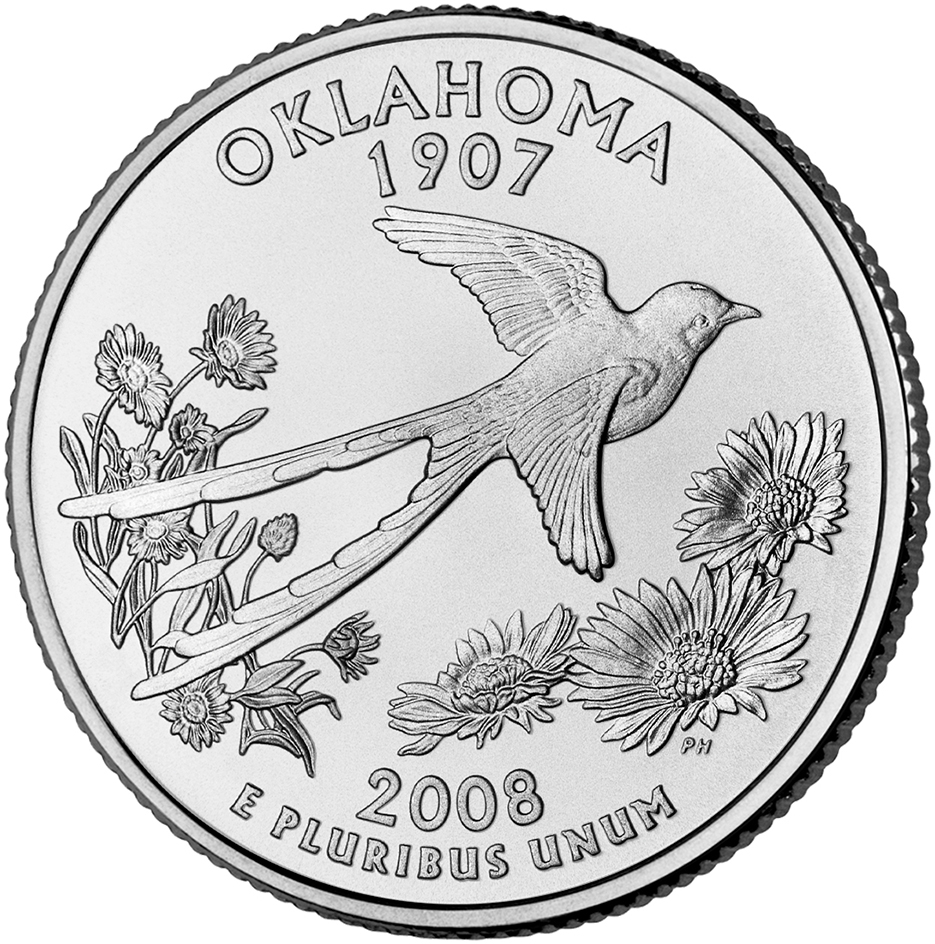
Both these periods of Oklahoma history have become famous. The story of the state’s farmers and cattlemen in territorial days is told in the musical play Oklahoma! The title song from the play became Oklahoma’s state song. John Steinbeck’s famous novel The Grapes of Wrath included a fictional, but widely accepted, description of the drought of the 1930’s. See Grapes of Wrath, The; Oklahoma!.
Today, farmers protect their land from drought with modern soil and water conservation methods. The state’s oil and gas wells continue to yield their valuable products, and the state is working to attract new industries. Oklahoma City, the state capital and largest city in population, is one of the largest cities in area in the United States. It covers more than 600 square miles (1,550 square kilometers).
People
Population.
The 2020 United States census reported that Oklahoma had 3,959,353 people. The state’s population had increased about 6 percent over the 2010 census figure of 3,751,351. According to the 2020 census, Oklahoma ranks 28th in population among the 50 states.
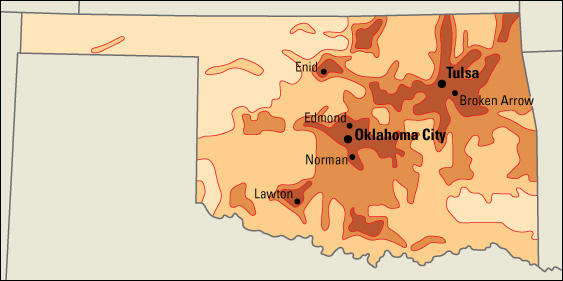
Most of the state’s population is concentrated in a corridor that runs from southwest to northeast Oklahoma. This corridor includes three of the state’s five metropolitan areas (see Metropolitan area). These areas are Oklahoma City, Tulsa, and Lawton. Another metropolitan area is based in Enid, which is in north-central Oklahoma. The fifth metropolitan area is based in Fort Smith, Arkansas, and extends into part of east-central Oklahoma.
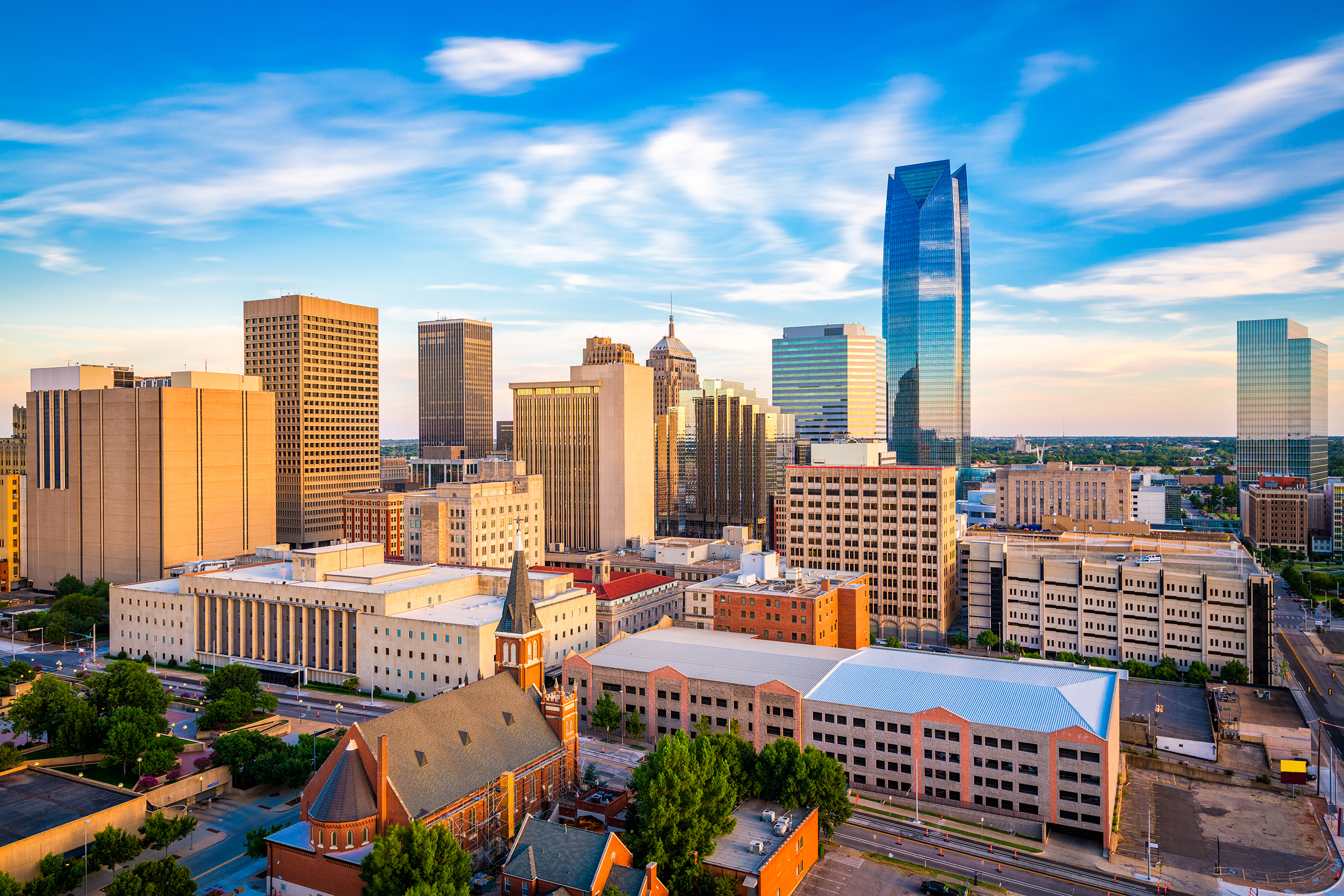
Oklahoma has 23 cities with populations of more than 20,000 people. The majority of these cities are near Oklahoma City or Tulsa. Oklahoma City is a center of industry and trade. Tulsa started as a Muscogee (Creek) village in the early 1800’s. The city boomed after oil was discovered in nearby Red Fork in the early 1900’s. Norman, the state’s third-largest city, is the home of the University of Oklahoma. Lawton serves Fort Sill, a neighboring military center.
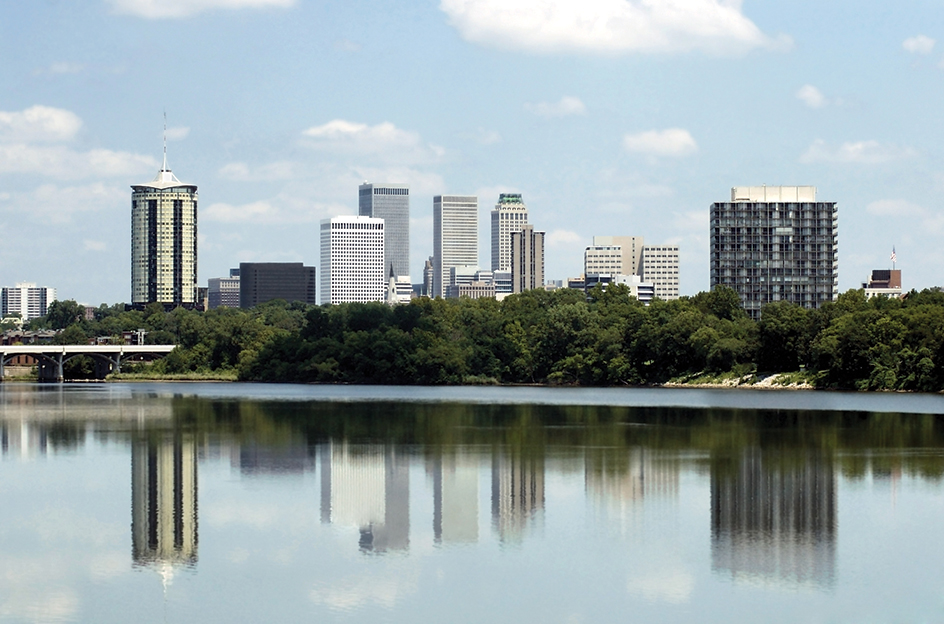
Oklahoma’s largest population groups include people of European and Indigenous American descent. Other sizable groups include Hispanic people and African Americans.
Schools.
The first schools in Oklahoma were established for Indigenous Americans in the 1820’s by missionaries. By the late 1840’s, several Indigenous peoples, including the Cherokee and the Choctaw, had established their own advanced educational systems. Schools for white children were first established in Oklahoma in 1890.
Oklahoma’s present school system is headed by an elected state superintendent of public instruction. The superintendent works with the State Board of Education, whose members are appointed by the governor. Riverside Indian School in Anadarko, founded in 1871, is one of the few remaining federally operated boarding schools for Indigenous children. By law, children from age 5 through age 18 must attend school. For the number of students and teachers in Oklahoma, see Education (table: U.S. students, teachers, and school expenditures).
Libraries.
Oklahoma has a system of public libraries and a number of college and university libraries. The first public library in Oklahoma was founded in Guthrie in 1901.
The Oklahoma Department of Libraries and the library division of the Oklahoma Historical Society are both in Oklahoma City. The University of Oklahoma Library in Norman has the History of Science Collections, the Harry W. Bass Business History Collection, and a collection of materials on the history of the American West.
Museums.
Oklahoma’s museums own many fine collections on Indigenous American history and art. The Gilcrease Museum, in Tulsa, is devoted largely to such collections. Lawton is the home of the Museum of the Great Plains. The Woolaroc Museum near Bartlesville owns one of the world’s finest collections of Indigenous blankets. The Southern Plains Indian Museum is in Anadarko.
The Oklahoma History Center is in Oklahoma City. The National Cowboy & Western Heritage Museum, also in Oklahoma City, features art of the American West. In addition, it houses the Rodeo Hall of Fame, the Hall of Great Westerners, and the Hall of Great Western Performers. See National Cowboy & Western Heritage Museum.
The Philbrook Museum of Art in Tulsa displays paintings from the Italian Renaissance and collections of African and Indigenous American art. Science Museum Oklahoma, in Oklahoma City, includes exhibits that visitors are encouraged to touch and explore. The 45th Infantry Museum, also in Oklahoma City, features various exhibits related to the state’s contributions to the nation’s defense. Fort Sill, a military center near Lawton, has an artillery museum that displays unusual weapons. 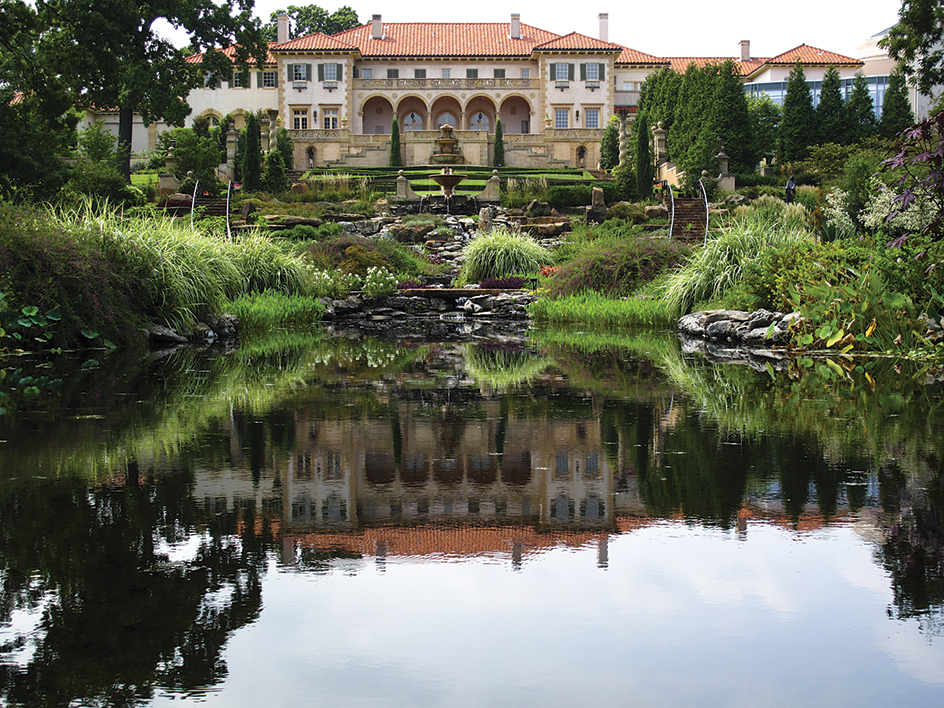
Visitor’s guide
Will Rogers, the famous Oklahoma cowboy humorist, once said: “There ought to be a law against anybody going to Europe until they have seen the things we have in this country.” Rogers may have been thinking of some of the scenic spots in his home state. Oklahoma’s attractions include beautiful lakes, rugged terrain, prairie vistas, and striking modern buildings. A statue at the Will Rogers Memorial Museum, in Claremore, bears his famous statement: “I never met a man I didn’t like.”
Many Oklahoma towns and cities hold annual festivals that celebrate local history, food, and cultures. Each year on Labor Day weekend, the Choctaw Nation holds a festival near Tuskahoma featuring music, dancing, art exhibitions, and a powwow (kind of ceremony) with members of many Indigenous tribes.
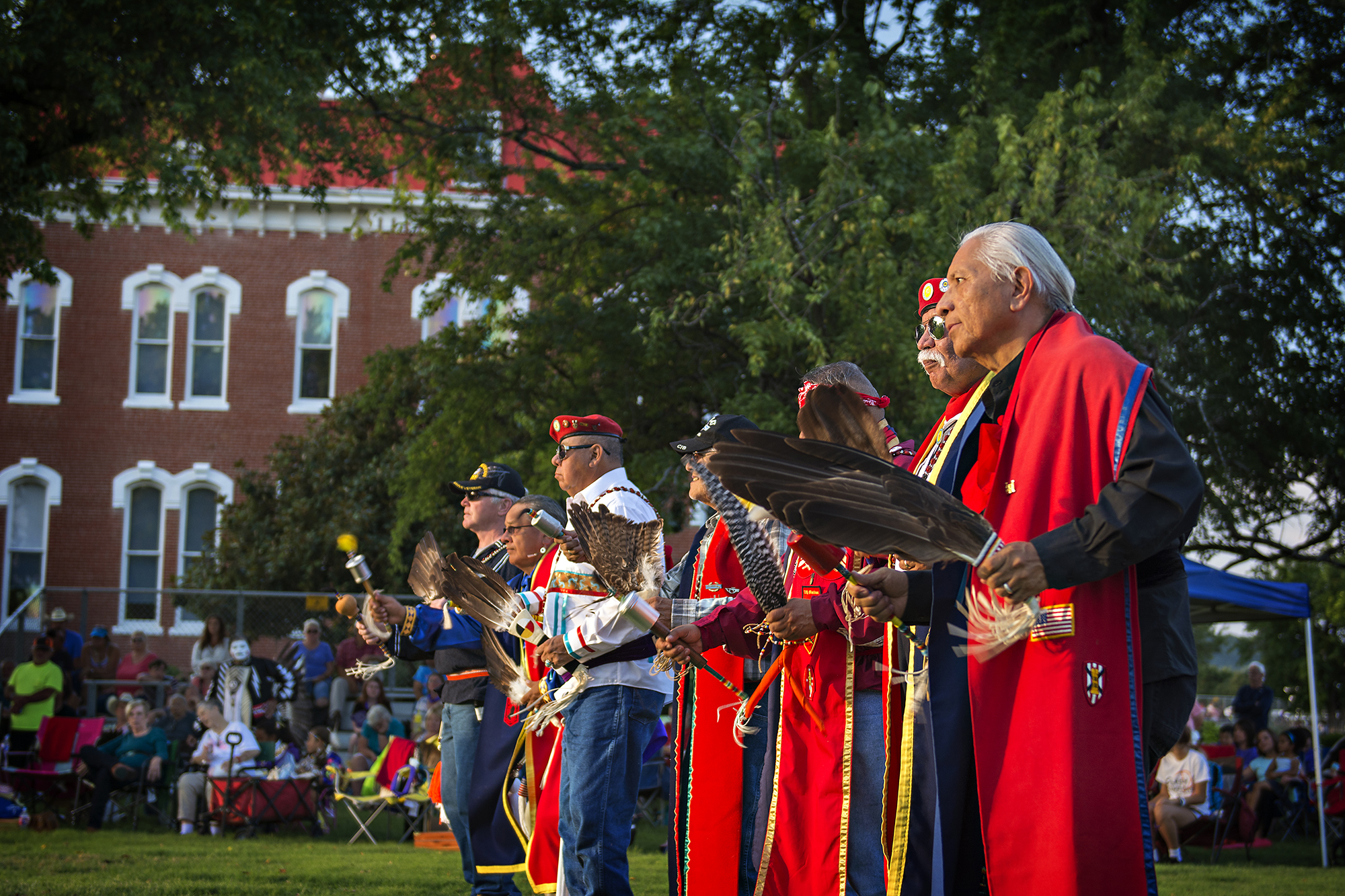
Land and climate
Land regions.
Oklahoma has 10 main land regions. These regions are (1) the Ozark Plateau, (2) the Prairie Plains, (3) the Ouachita Mountains, (4) the Sandstone Hills, (5) the Arbuckle Mountains, (6) the Wichita Mountains, (7) the Red River Region, (8) the Red Beds Plains, (9) the Gypsum Hills, and (10) the High Plains.
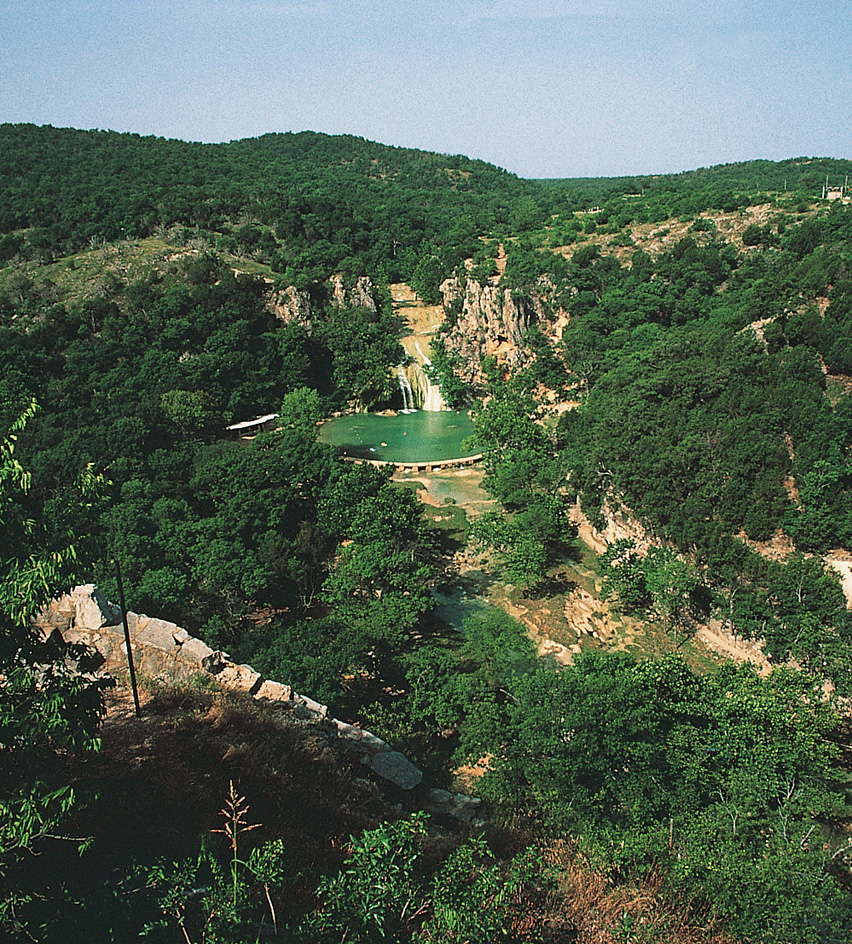
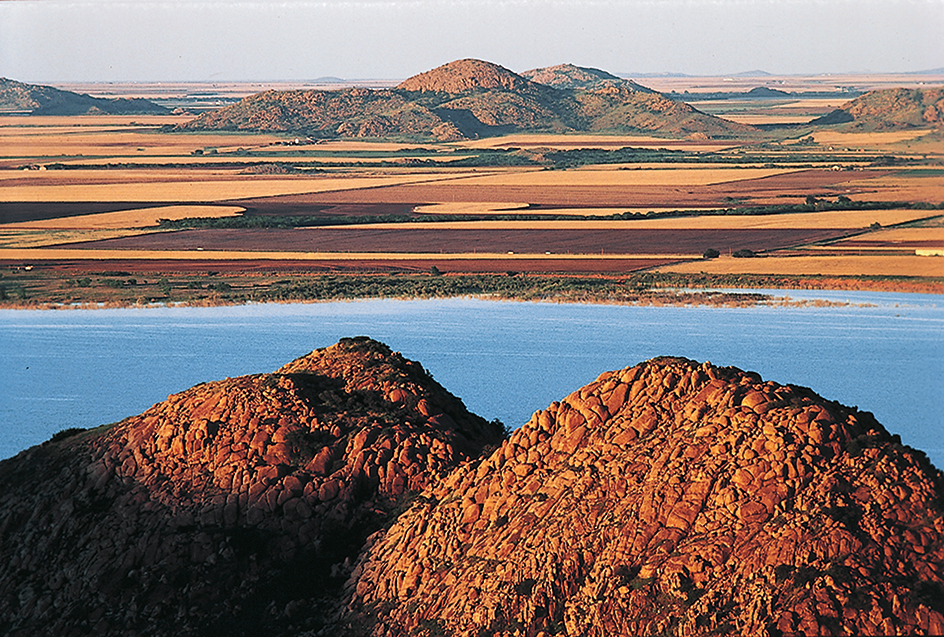
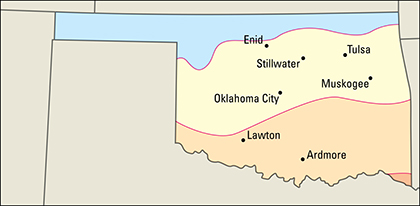
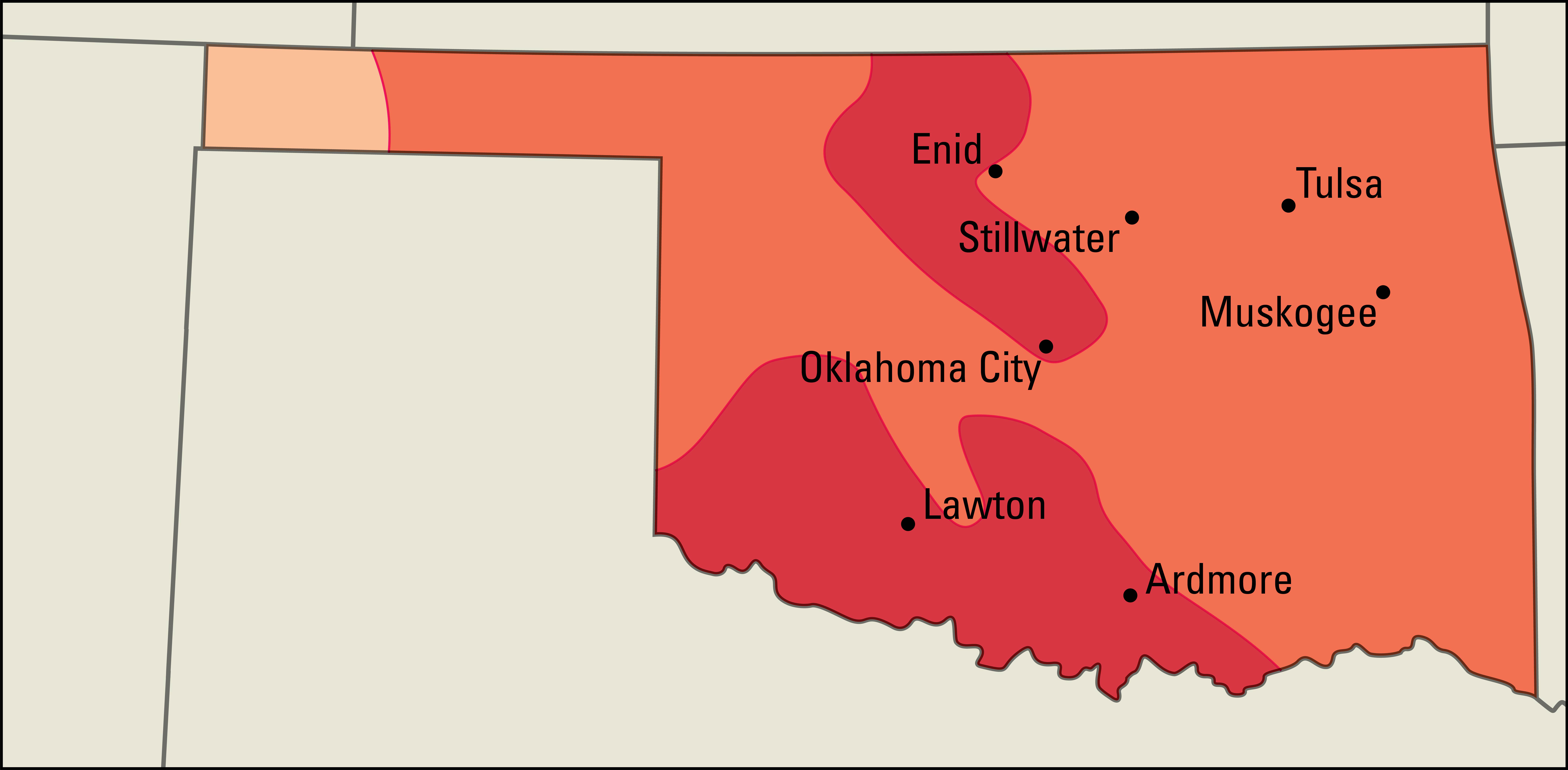
The Ozark Plateau
extends into the northeastern part of Oklahoma from Missouri and Arkansas. This hilly region has swift streams and steep-sided river valleys. The areas between the river valleys are broad and flat. Steep bluffs have been formed where streams cut into the plateau.
The Prairie Plains
include the land west and south of the Ozark Plateau. Farming and cattle ranching are the most important activities in this region. The Arkansas River Valley, east of Muskogee, produces such pasture crops as alfalfa and hay. Much of the area’s cultivated land also produces corn, soybeans, and nursery products. Much of the state’s coal comes from this region.
The Ouachita Mountains
rise in the southeastern part of the state on the border between Oklahoma and Arkansas. These mountains are a series of high sandstone ridges that form the roughest land surface in Oklahoma. The ridges run in a general east-west direction. They include Blue Bouncer, Buffalo, Jackfork, Kiamichi, Rich, and Winding Stair. The timber industry and poultry farms are major contributors to the region’s economy.
The Sandstone Hills
region extends south from the border with Kansas to near the Red River in southern Oklahoma. It is a region of hills 250 to 400 feet (76 to 120 meters) high. Many areas are covered with blackjack and post oak forests. Much of the early Oklahoma oil development took place in these hills. The Sandstone Hills region still has important oil fields. Ranching is also important there.
The Arbuckle Mountains
are wedged into an area of 1,000 square miles (2,600 square kilometers) in south-central Oklahoma. Millions of years ago, these were tall mountains. Erosion has worn them down until they now rise only 600 to 700 feet (180 to 210 meters) above the surrounding plains. The erosion uncovered unusual rock formations that are often studied by geology students. The principal formations of this region include conglomerates, granite, limestone, sandstone, and shale. Ranchers use the land to raise cattle.
The Wichita Mountains
are rough granite peaks in southwestern Oklahoma. The region has a number of small artificial lakes. These lakes were created by damming the mountain streams to provide water for the irrigation of cotton fields. Such lakes remain important for recreational use. The Fort Sill Military Reservation and a federal wildlife refuge lie mostly within the Wichita Mountains region.
The Red River Region
is a rolling prairie and forest area. Much of the soil is sandy and very fertile. Farmers in the region grow cotton, peanuts, and vegetables.
The Red Beds Plains
extend from Kansas to Texas in a wide sweep through the middle of Oklahoma. Soft red sandstone and shale lie under the soil. This gently rolling plain, Oklahoma’s largest land region, slopes downward from west to east. The eastern part has woodland areas, and the western part is mostly grassy. The region has fairly fertile soil. Farmers grow cotton and wheat in the southwestern part. Oil fields have been developed in some parts of the Red Beds Plains.
The Gypsum Hills
is an area of varied terrain in western Oklahoma. The region includes rolling sand dunes, flatlands, and isolated tablelands of small mesas and buttes called the Glass << glahs >> Mountains. The mountains are named for the crystals of selenite—a variety of the mineral gypsum—that cover their surface.
The High Plains,
an area of level grassland, occupy the state’s northwestern section, which includes Oklahoma’s Panhandle. The Panhandle is the western portion of Oklahoma, a strip of land 166 miles (267 kilometers) long and 34 miles (55 kilometers) wide. The land of the High Plains rises from about 2,000 feet (610 meters) on the eastern edge of the region to 4,973 feet (1,516 meters) at Black Mesa, the highest point in Oklahoma, in the northwestern corner of the state.
Rivers and lakes.
Oklahoma is drained by two great river systems—the Red and the Arkansas. These systems carry water from the state’s rivers and streams eastward to the Mississippi River, which empties into the Gulf of Mexico. The winding Red River forms Oklahoma’s southern boundary with Texas. Its main tributaries drain southern Oklahoma. These streams include the Blue, Kiamichi, Little, Mountain Fork, and Washita rivers; Cache Creek; and the North Fork of the Red River. See Red River.
The Arkansas River flows through northeastern Oklahoma. Its principal southern tributaries flow in a broad, irregular semicircle across the entire width of the state. These include the Canadian, North Canadian, and Cimarron rivers. The Chikaskia, Illinois, Neosho (or Grand), Poteau, Salt Fork, and Verdigris rivers, which drain northern and eastern Oklahoma, are also important branches. See Arkansas River.
Oklahoma has more than 200 artificially created lakes and about 100 small natural lakes. Lake Texoma, covering 91,200 acres (36,910 hectares), is the most popular resort center (see Lake Texoma). Part of it lies in Texas. Grand Lake O’ The Cherokees is in northeastern Oklahoma (see Grand Lake O’ The Cherokees). It backs up the waters of the Neosho River for 65 miles (105 kilometers). Lake Eufaula, in the east-central portion, covers over 100,000 acres (40,000 hectares). Fort Gibson Lake, Greenleaf Lake, Lower Spavinaw Lake, Upper Spavinaw Lake, Tenkiller Ferry Lake, and Lake Wister are in eastern Oklahoma. They have resorts for fishing and boating. Other lakes and reservoirs in Oklahoma include Altus, Canton, Ellsworth, Fort Supply, Foss, Great Salt Plains, Heyburn, Keystone, Lawtonka, Murray, and Oologah.
Plant and animal life.
Forests cover about a fifth of Oklahoma. Important trees include ashes, elms, hickories, oaks, pines, sweet gums, and walnut trees. The main commercial forests are in southeastern Oklahoma.
Prairie grasses in the state provide important habitat for many native species, while providing grazing for millions of cattle. Among these grasses are bluestems, Indian grass, sand grass, and the shorter buffalo grass, grama, and wire grass. Other common prairie plants are mesquite and sagebrush. Dogwoods and redbuds grow in the east, central, and southern areas. Anemones, goldenrods, wild indigos, petunias, phlox, primroses, spiderworts, sunflowers, black-eyed Susans, verbena, and violets grow in all regions of Oklahoma.
Armadillos, coyotes, prairie dogs, and rabbits are common on the plains of Oklahoma. Forest animals include deer, opossums, raccoons, foxes, and gray and fox squirrels. Common birds in the state include blue jays, cardinals, crows, doves, meadowlarks, mockingbirds, robins, scissor-tailed flycatchers, and house sparrows. Fishes in Oklahoma’s waters include bass, buffalo fish, carp, catfish, crappie, drumfish, paddlefish, and sunfish.
The Oklahoma Department of Wildlife Conservation serves a large population of active hunters and fishermen. Significant game species include whitetail deer, turkey, and quail. Catfish, hatchery-raised trout, and several kinds of bass are popular sportfishing species.
Climate.
Most of Oklahoma has a warm, dry climate. Northwestern Oklahoma is cooler and drier than the southeastern part. Precipitation (rain, melted snow, and other forms of moisture) varies greatly throughout the state. Average precipitation ranges from 50 inches (130 centimeters) a year in the southeast to 18 inches (46 centimeters) in the western Panhandle. Snowfall ranges from about 2 inches (5 centimeters) a year in the southeast to 30 inches (76 centimeters) in the northwest. The Panhandle gets the most snow. 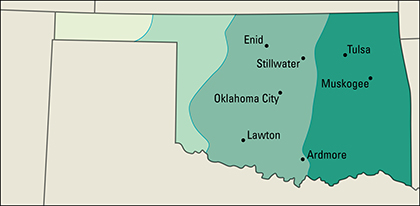
The average July temperature in Oklahoma is 82 °F (28 °C), and the average January temperature is 38 °F (3 °C). The state’s highest temperature, 120 °F (49 °C), was recorded on four occasions during the summer of 1936—at Alva on July 18, at Altus on July 19 and August 12, and at Poteau on August 10. The record low temperature, –31 °F (–35 °C), was registered at Nowata on Feb. 10, 2011.
Economy
Service industries, taken together, account for the largest part of Oklahoma’s gross domestic product—the total value of goods and services produced in the state in a year. Mining is also important. Oklahoma ranks as a leading producer of natural gas and petroleum. Beef cattle are the leading farm product.
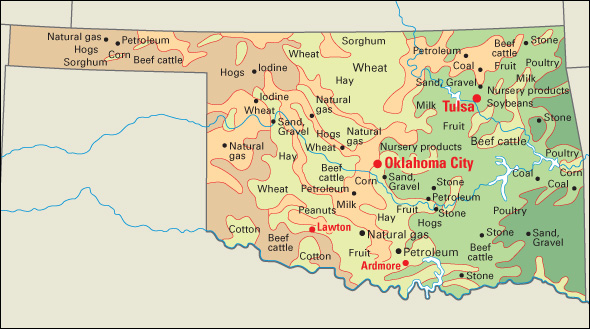
Natural resources.
Oklahoma has vast reserves of minerals and large areas of fertile soils. Its mineral wealth includes petroleum and natural gas. Large supplies of water and a favorable climate combine with rich soils to make Oklahoma a major food producer.
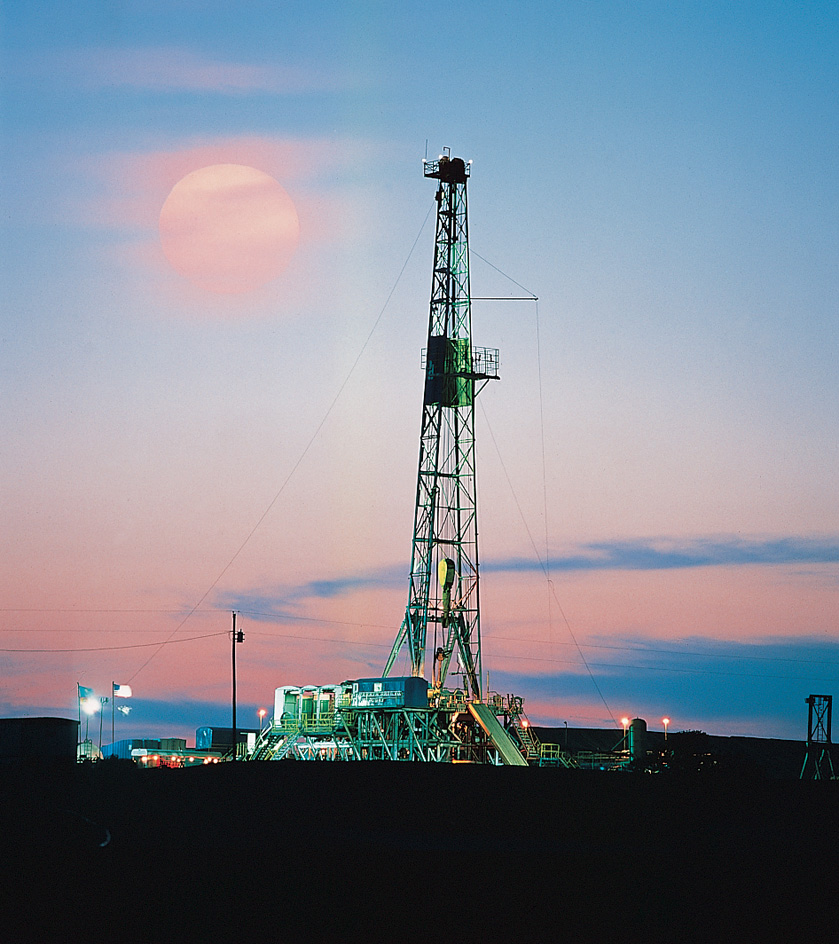
Minerals.
The state’s oil reserves are among the largest in the nation. Natural gas is also present in most of the oil fields. Deposits of natural gas and petroleum have been found in nearly every county in Oklahoma.
Small beds of coal lie in the east-central and northeastern parts of the state. The eastern part also has clays and stone. Other mineral resources include gypsum, iodine, limestone, salt, and sand and gravel. The natural gas of the Panhandle contains helium.
Soil
varies from the fertile deposits in the river valleys to the unproductive shale and granite of the mountains. Much of the plains and grasslands area has a rich, productive soil. Other areas have poor red clay soil.
Service industries
account for the largest portion both Oklahoma’s employment and its gross domestic product. Most service industries are concentrated in the Oklahoma City and Tulsa metropolitan areas.
Oklahoma City and Tulsa are the state’s chief financial and insurance centers. Most hotels, restaurants, and retail trade establishments are also in the Oklahoma City and Tulsa areas. Oklahoma City, the state capital, is the center of government activities. The University of Oklahoma Health Sciences Center in Oklahoma City is one of the nation’s leading medical facilities. Tinker Air Force Base, near Oklahoma City, is a major employer in the state. Several rental car companies are headquartered in Tulsa. American Airlines also has a large facility there.
Some service industries are dedicated to Oklahoma’s oil production. The wholesale trade of oil and gas is important in the state. Pipeline companies transport the state’s huge oil and gas production. Companies that rent oil field equipment are also important to Oklahoma.
Manufacturing.
Much of Oklahoma’s manufacturing is dedicated to processing its agricultural and mining products. Dozens of meat-packing plants operate in the state. Bakery goods are also made in Oklahoma. Large oil refineries operate in Ardmore, Ponca City, Tulsa, and Wynnewood. Several cities make oil field machinery.
Fabricated metal products, machinery, and transportation equipment are primarily made in the Oklahoma City and Tulsa areas. Fabricated metal products include heat exchangers and machine shop products. Machinery products include construction machinery, engines and turbines, and refrigeration and heating equipment. Buses, motor vehicle parts, and trucks are important transportation products made in the state. Plants in Tulsa make aircraft and aerospace equipment. Factories in Ardmore and Lawton produce tires. 
Mining.
Natural gas and petroleum are Oklahoma’s leading mineral products by far. Oklahoma ranks among the leading states in both natural gas and petroleum production. The heaviest natural gas production occurs in the western part of the state. Two-thirds of Oklahoma’s gas is piped to other states. Central Oklahoma is the leading area for petroleum production.
Oklahoma is one of the leading producers of gypsum in the United States. Other mineral products include coal, crushed stone, iodine, and sand and gravel. Most coal is produced in eastern Oklahoma. Limestone quarries in northeast and south-central Oklahoma provide much of the crushed stone. Oklahoma is the only state that produces iodine. It is mainly produced in the northwest part of the state as a by-product of oil field brine. Sand and gravel come mainly from pits near Oklahoma City and Tulsa.
Agriculture.
Farmland covers about three-fourths of Oklahoma. The production of beef cattle is the leading source of agricultural income, and Oklahoma is one of the country’s most important sources of beef. Ranchers throughout Oklahoma raise beef cattle. Other important livestock income comes from broilers (young, tender chickens), hogs, and milk. Oklahoma’s farmers raise broilers in the eastern portion of the state. Hogs are primarily raised in the Panhandle and central part of the state. Dairy farms are found in Grady County and in the northeastern and southwestern portions of the state.
Winter wheat is one of the state’s most valuable field crops, and Oklahoma is a leading wheat-growing state. Wheat is grown throughout the state. Corn is also an important field crop. Oklahoma is the leading producer of rye. The state’s other important crops include cotton, grain sorghum, hay, oats, peanuts, pecans, and soybeans. Greenhouse and nursery products are an important source of income.
Electric power and utilities.
Coal-burning plants, plants that burn natural gas, and wind power plants provide the vast majority of the electric power generated in Oklahoma. Hydroelectric plants in the eastern part of the state provide most of the remaining electric power.
Transportation.
Oklahoma has hundreds of thousands of miles of roads and highways. The state has an extensive system of toll highways, including the Turner Turnpike, which links Oklahoma City and Tulsa.
Freight railroads operate on thousands of miles of rail line in Oklahoma. The state’s first railroad was the Missouri-Kansas-Texas Railroad, called the “Katy.” It was built across Oklahoma to Denison, Texas, from 1870 to 1872. Passenger trains connect Oklahoma City with Fort Worth, Texas. Oklahoma City and Tulsa have the state’s major commercial airports. Muskogee and the Tulsa Port of Catoosa are Oklahoma’s chief ports. The McClellan-Kerr Arkansas River Navigation System links these two port cities with Mississippi River ports.
About 40,000 miles (64,000 kilometers) of pipelines carry Oklahoma’s oil, natural gas, and refined products to other states. Most of the pipelines run through central Oklahoma from southwest to northeast.
Communication.
Oklahoma’s first newspaper, the Cherokee Advocate, was published in Tahlequah in 1844. It was printed in both English and Cherokee. Today, the largest newspapers are The Oklahoman of Oklahoma City and the Tulsa World.
Government
Constitution.
The Oklahoma Constitution was adopted in 1907, the year Oklahoma became a state. It may be amended by a majority vote of the people. Amendments may be proposed by the Legislature or by petitions from the voters. A constitutional convention may be called by the Legislature, subject to voter approval. The Constitution contains initiative and referendum clauses that allow the voters to propose and pass laws directly (see Initiative and referendum).
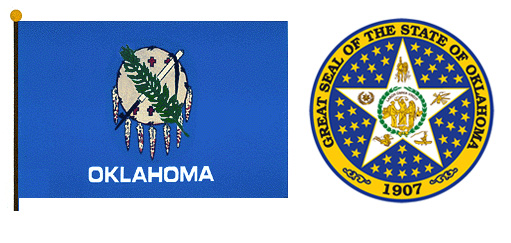
Executive.
The governor serves a four-year term and may serve no more than two terms. The governor appoints the secretary of state and the heads of the chief revenue and budget departments. Some department heads are chosen by a board or by a commission. The lieutenant governor, attorney general, treasurer, auditor and inspector, superintendent of public instruction, insurance commissioner, and labor commissioner are all elected to serve four-year terms. Corporation commissioners are elected to six-year terms.
Legislature
of Oklahoma consists of a Senate with 48 members and a House of Representatives with 101 members. Each senator and representative is elected from a separate district. Senators are elected to four-year terms and representatives to two-year terms. Each senator and representative is limited to no more than 12 total years of elected service as a state legislator. The Legislature meets in annual sessions that begin on the first Monday in February. In odd-numbered years, the Legislature also meets on the first Tuesday after the first Monday in January to verify election results. 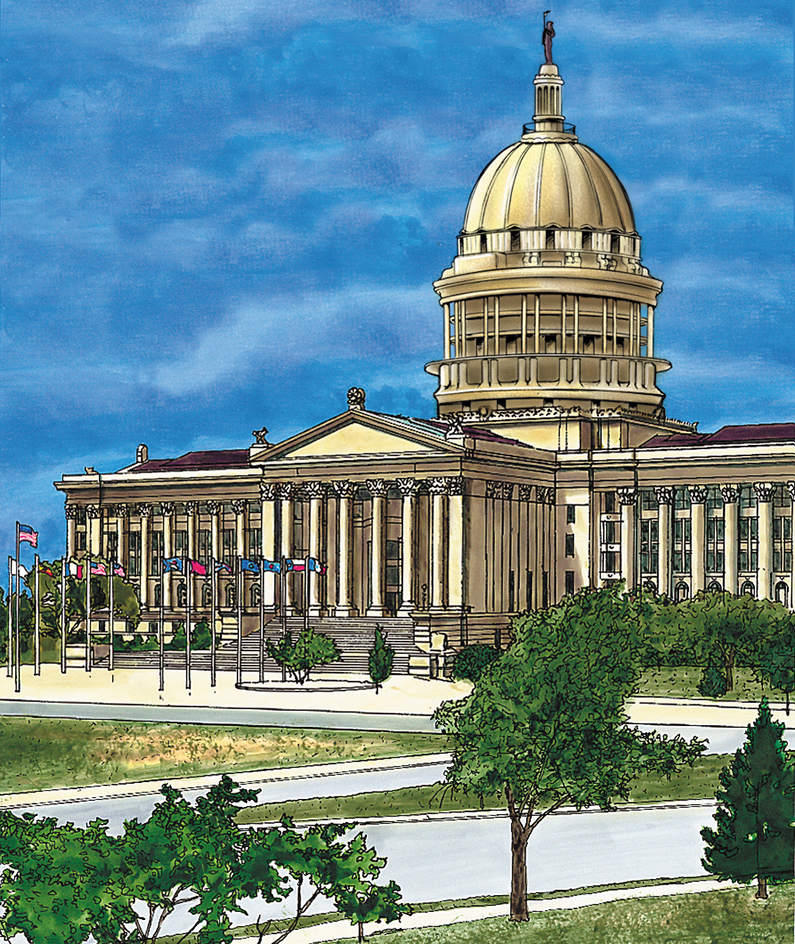
Courts.
The Oklahoma Supreme Court has nine justices. They select a chief justice from their group. The governor appoints the justices with the advice of a judicial nominating commission. At the first general election following the appointment, voters decide on nonpartisan ballots whether to retain or dismiss the justice. A vote of retention means the justice may then serve a six-year term. The state also has a Court of Civil Appeals with 12 judges and a Court of Criminal Appeals with 5 judges. All of these judges are chosen in the same way that Supreme Court justices are selected.
Local government
in Oklahoma operates in 77 counties and in hundreds of cities and towns. The counties have three commissioners, each elected from a separate district. Most cities and towns use the mayor-council or council-manager form of government. Larger cities can adopt and amend their own charters, and thus can take some control over their affairs.
Revenue.
State taxes provide about half of the state government’s general revenue (income). Major sources of tax revenue include a personal income tax, a sales tax, taxes on motor fuel and motor vehicle licenses, and a severance tax on petroleum and natural gas production. Most of the rest of the revenue comes from U.S. government programs.
Politics.
Oklahoma was once almost solidly Democratic. The state began to develop a two-party system during the 1960’s. Oklahoma voters elected the state’s first Republican governor in 1962. Oklahomans have favored Republican candidates in most presidential elections held since 1948.
History
Early days.
Groups of Indigenous people roamed the plains of the region that now includes Oklahoma before white people arrived there. These Indigenous groups included the Plains Apache, Caddo, Cheyenne, Comanche, Kiowa, Osage, Pawnee, and Wichita. They followed the huge herds of buffalo that grazed on the grasslands.
Europeans first reached the Oklahoma region in 1541. That year, the Spanish explorer Francisco Vásquez de Coronado led an expedition from Tiguex, New Mexico. He reached what is now Oklahoma. Later the same year, Hernando de Soto, another Spaniard, probably entered the area. Both Coronado and De Soto were searching for gold, but they found none.
In 1682, the French explorer René-Robert Cavelier, Sieur de La Salle, traveled down the Mississippi River. He did not reach the Oklahoma area. However, he claimed for France all the land drained by the Mississippi, including the Oklahoma region. Soon afterward, other French explorers—notably Bernard de La Harpe—and traders entered the Oklahoma area.
United States ownership.
France claimed the Oklahoma region as part of Louisiana until 1762, when France ceded Louisiana to Spain. Napoleon I regained the province for France in 1800, but he needed money to fight wars in Europe. In 1803, he sold Louisiana to the United States (see Louisiana Purchase).
Congress reorganized the administration of Louisiana several times. The section that included present-day Oklahoma was first called the District of Louisiana. In 1805, it became the Louisiana Territory. Seven years later, in 1812, the Missouri Territory was organized from the Louisiana Territory. In 1819, the United States settled several boundary disputes with Spain. As a result, the present Oklahoma Panhandle, one of the disputed areas, was given to Spain. The rest of Oklahoma became part of the Arkansas Territory, which was created in 1819. Miller Court House (in present-day McCurtain County), Salina, and Three Forks were among the first white settlements established in Oklahoma.
The Indigenous American nations.
After 1819, the federal government began prodding Indigenous Americans in the southeastern United States to move to the Oklahoma area. The Cherokee, Chickasaw, Choctaw, Muscogee (Creek), and Seminole had lived in close contact with white people for more than a hundred years. They adopted many of the habits and customs of white Americans, and they became known as the Five Civilized Tribes.
In the early 1800’s, Oklahoma was largely unoccupied. In 1824, to prepare the area for the immigration of Indigenous Americans, the U.S. Army built Fort Towson and Fort Gibson. The government soon forced the five tribes to give up most of their eastern lands and begin the move west.
From 1830 to 1842, sad processions of Indigenous people moved into the hills and grasslands of eastern Oklahoma. Thousands died along the way. Those who moved included the Cherokee, who called their own trip the Trail of Tears. This term is sometimes used to refer to the removal of other peoples as well.
The Indigenous Americans who migrated were given the right to all of present-day Oklahoma except the Panhandle. Each of the five tribes formed a nation. Through treaties, the United States promised to protect those nations. The government guaranteed that the Indigenous people would own their lands “as long as grass shall grow and rivers run.” Each Indigenous American nation established its own legislature, courts, and written laws, and each built its own capital. Most settlements were in the eastern part of the region.
After the first hard years, Indigenous groups began to build schools and churches, clear land, and operate farms and ranches. They were protected from white settlement by their treaties, so the general westward movement of the pioneers passed them.
The American Civil War
(1861-1865) destroyed the prosperity and protection of the Indigenous people. Members of the Five Civilized Tribes had come from the South, and many of them were slaveholders. Delegations from Texas and Arkansas urged the Indigenous people to join the Confederacy. In 1861, a Confederate military leader named Albert Pike made treaties of alliance with some Indigenous groups, including some Plains peoples who had moved into the area. At first, the Cherokee leader Chief John Ross avoided taking sides. But after the Confederates won a battle at Wilson’s Creek in Missouri, near the Cherokee border, Ross pledged the Cherokee to the South. Pike then recruited and led a brigade of Indigenous Americans to fight for the South. One Cherokee, Stand Watie, became a Confederate brigadier general. However, other Indigenous groups fought for the Union. See Ross, John; Watie, Stand.
After the Civil War,
Congress forced the Five Civilized Tribes to give up the western part of their land because they had supported the South. Some of this land was given or sold to other Indigenous groups.
The land that bordered the Indian Territory filled rapidly with settlers. Soon there was no more free or cheap land available. The white people wanted to use the fertile lands pledged to the Indigenous Americans. During the late 1860’s, many cattlemen drove their herds across Oklahoma on their way from Texas to the Kansas railroad centers. Some cattle ranchers paid the Indigenous people for grazing rights, but others did not. From 1866 to 1885, more than 6 million longhorn cattle crossed the Indigenous lands. The East Shawnee, West Shawnee, Chisholm, and Western trails were the leading routes. In 1883, an association of cattle ranchers leased more than 6 million acres (2.4 million hectares) of Indigenous land for five years. But the U.S. government declared all the leases invalid. President Benjamin Harrison ordered the cattle removed in 1890.
The great land rushes.
“Boomers” urged the government to open the lands of Indigenous people for white settlement. The boomer leaders included C. C. Carpenter, David L. Payne, and William L. Couch. Finally, the government yielded. It bought more than 3 million acres (1.2 million hectares) from the Muscogee and Seminole. Authorities declared almost 1,900,000 acres (769,000 hectares) in central Oklahoma open for settlement at noon on April 22, 1889. Thousands of settlers moved to the border to await the opening. The army held them back until a pistol shot signaled the opening. Then a wild race began to claim the best farms and townsites. About 50,000 people had moved into Oklahoma by that evening. In a single day, Guthrie and Oklahoma City became cities of 10,000 people.
Some settlers, called Sooners, went into the area before the opening to claim the best land. To hide their early entry, many Sooners ran their horses hard on the day of the opening. Then the tired horses would be shown to the pioneers who had followed the rules, to “prove” that the owner had just arrived.
The Territory of Oklahoma was established by Congress in May 1890, with Guthrie as the capital. The same act added the Panhandle to the territory. The Panhandle had become U.S. territory when Texas joined the Union in 1845. President Harrison appointed George W. Steele as the first territorial governor.
Many African American settlers came to the Great Plains in the late 1800’s. They fled the hostile environment they faced in the South after the Reconstruction period that followed the Civil War. Such all-Black towns as Langston were established in Oklahoma.
During the 1890’s, more and more Indigenous groups accepted individual allotment of their lands. This meant that individuals, not nations, owned the land. Land not allotted to tribe members was opened for settlement. In some areas, settlers got their land by run (land rush). Other land was distributed by a lottery.
The greatest opening occurred on Sept. 16, 1893. That day, the Cherokee Outlet, in north-central Oklahoma, and the Tonkawa and Pawnee reservations were opened. Over 50,000 people claimed land in the 61/2 million-acre (2.6 million-hectare) area the first day.
Progress toward statehood.
After 1890, maps showed the Oklahoma area as the Twin Territories—Indian Territory and Oklahoma Territory. Indian Territory was the remaining land of the Five Civilized Tribes, plus a small area owned and settled by other groups. The rest of the region was Oklahoma Territory. 
White settlers now wanted the remaining Indigenous lands. In 1893, Congress created the Dawes Commission to bargain for the land and to dissolve the Indigenous nations. Agents of the commission helped tribes incorporate towns and prepare for citizenship. The commission divided the remaining land among tribal members. By 1905, commission leaders felt the Indian Territory was ready to become a state.
Leaders of the Five Civilized Tribes called a constitutional convention at Muskogee in 1905 and invited white citizens to take part. At the time, white people in the Indian Territory outnumbered Indigenous Americans five to one. The convention adopted a constitution for the proposed state of Sequoyah, and the people approved it in an election. But Congress refused to accept the area as a state. Congress wanted one state to be created from the Twin Territories. In 1906, delegates from both territories met in Guthrie to draw up a constitution.
Early statehood.
On Nov. 16, 1907, Oklahoma became the 46th state in the Union. Charles N. Haskell of Muskogee was elected the first governor. The new state had a population of 1,414,177. Guthrie was the first capital. In 1910, Oklahoma City became the capital.
Even before statehood, Oklahoma had become a center of oil production. A small well was drilled near Chelsea in 1889. The first important well was drilled at Bartlesville in 1897. Tulsa became an oil center after the Red Fork-Tulsa field was opened in 1901.
There were problems, however, especially among farmers. The prices of farm products were low, and many settlers found they did not have enough land to farm profitably. After the United States entered World War I in 1917, these problems disappeared in the huge demand for Oklahoma’s farm and fuel products.
The 1920’s.
During the 1920’s, many of Oklahoma’s problems returned. Farm prices dropped again, and economic distress led to unrest. Secret organizations, including the Ku Klux Klan (KKK), stirred into action. The Klan, a white organization opposed to the advancement of Black people and other minority groups, won many members all over the state. It controlled or elected many municipal and county officials. Racial tensions contributed to the Tulsa race massacre of 1921, one of the deadliest acts of racial violence in U.S. history. Many Black people were killed, and the city’s Black business district was destroyed. James B. A. Robertson, who served as Oklahoma’s governor from 1919 to 1923, fought the Klan and refused to allow any state official to join the organization.
In 1923, John C. Walton became governor, but he was soon impeached for abusing his powers. The state legislature removed him from office after only 9 months and 14 days. Among other things, Walton had used the National Guard to prevent a grand jury from meeting. Lieutenant Governor Martin E. Trapp became governor and served until 1927. Trapp was a “hard roads” governor who pushed the construction of all-weather highways. Trapp also backed a law that made it illegal to wear masks at public gatherings. This law helped control the Klan. Henry S. Johnston became governor in 1927, but he, too, was impeached. After two years in office, Johnston was found guilty of incompetence and removed by the legislature. In March 1929, Lieutenant Governor William J. Holloway became governor.
Important discoveries of oil and gas helped Oklahoma during this period. The huge Oklahoma City field was opened in 1928. It had more than 1,500 producing wells within 10 years. The Greater Seminole area led the nation in production from 1925 to 1929.
The 1930’s.
The campaign of 1930 was highlighted by the election as governor of one of Oklahoma’s most colorful politicians, William H. “Alfalfa Bill” Murray. A former congressman, Murray appealed to the “common folks” to vote for him. After his election, Murray shut down over 3,000 flowing oil wells. The price of oil had been dropping, and Murray wanted to keep some oil off the market to force up the price. After three months, he permitted production to start again.
Oklahoma suffered many hardships during the Great Depression of the 1930’s. Business was bad, and farm prices were extremely low. Many banks failed, and people lost their savings. The entire Great Plains region suffered a severe water shortage. Crops failed for lack of rain, and there were unusually hot summers. High winds stripped away large areas of fertile topsoil and whipped the dry dirt into massive dust storms that turned day into night. Much of the plains area became known as the Dust Bowl (see Dust Bowl). Many farmers, miners, and oil workers left the state to try their luck elsewhere. Oklahoma suffered a large loss of population. See Great Depression (Human suffering). 
The mid-1900’s.
During World War II (1939-1945), Oklahoma’s major products—food and fuels—again came into great demand. Increased use of soil conservation practices helped restore many farms that had been damaged during the drought of the 1930’s.
From 1943 to 1947, Governor Robert S. Kerr brought about reforms in education, state finances, and pardon and parole procedures for convicts. After serving his term as governor, Kerr won election to the United States Senate.
During the 1950’s, Oklahoma’s economy began to shift from an agricultural to an industrial base. Both the size and number of farms declined. Johnston Murray, the son of Alfalfa Bill Murray, became governor in 1951 and started a campaign to develop new industry in the state. His successor, Raymond D. Gary, continued Oklahoma’s industrial expansion.
New industries and construction projects highlighted the state’s economic progress during the 1960’s. Two large electronics plants were built in Oklahoma City, and Tulsa became the site of a space equipment factory. The Federal Aviation Administration built an aeronautics center in Oklahoma City. This center trains workers for civil aviation jobs, such as that of control tower operator, and conducts research into airplane crashes. In 1963, Henry Bellmon became the state’s first Republican governor.
Construction of a number of dams and creation of several lakes began in the mid-1900’s. Some of these projects were completed in the 1960’s, and others were finished in the 1970’s. The lakes were created to increase the state’s hydroelectric power and water storage capacities. The new dams and lakes helped the efforts of business and political leaders to broaden the state’s industrial activity. The state government advertised Oklahoma’s abundant supplies of fuel, water, and electric power. In addition, the legislature revised the state’s tax structure to attract manufacturers. As a result, Oklahoma gained new industries that did not depend on the products of its farms and mines.
The late 1900’s.
The McClellan-Kerr Arkansas River Navigation System, completed in 1970, made shipping an important activity in Oklahoma. The waterway enables barges on the Mississippi River to reach Oklahoma ports on the Arkansas River. Tulsa and Muskogee are important ports on the river system.
Between 1976 and 1980, a strong world demand for energy led to an economic boom in Oklahoma. The state’s petroleum and natural gas industries thrived and brought much income to Oklahoma. In addition, rising tourism contributed to the state’s economy.
During the early 1980’s, however, the prices of oil and gas fell sharply, and the economic boom in the state ended. In addition, a deep decline in agricultural prices contributed to an economic crisis for thousands of Oklahomans. Hundreds of oil wells shut down, and many farmers lost their farms. The reduction in tax revenue from oil and gas production also led to cuts in public services. Unemployment increased rapidly, and many people left the state in search of jobs.
The economic crisis helped focus attention on the need to further broaden the state’s economy. Once again, state leaders emphasized the need to attract new industries that would help lessen Oklahoma’s dependence on its traditional mineral and agricultural industries.
In 1982, betting on horse races became legal in Oklahoma. In 1984, the state gave each county the right to decide whether to end restrictions on alcoholic beverage sales within its borders. In 1959, the state had repealed a 1907 law banning alcohol sales but left some restrictions in place. Oklahomans voted in 1990 to limit state legislators to no more than 12 total years of elective service. This was the first time any state’s voters passed such term limits.
In 1995, a bomb set off by American terrorist Timothy J. McVeigh blew up Oklahoma City’s Murrah Federal Building, killing 168 people. The incident was one of the worst terrorist acts in the United States. McVeigh was convicted of murder and conspiracy in 1997 and was executed in 2001. See Oklahoma City bombing. 
The 2000’s.
The Oklahoma City National Memorial, established on the site of the Murrah Federal Building, was dedicated in 2000. A new federal building was completed near the site in 2003.
In 2002, a dome was completed atop the State Capitol Building in Oklahoma City. In 2007, Oklahoma celebrated its centennial with parades and other events in Oklahoma City and Guthrie.
Devastating tornadoes have occurred in Oklahoma throughout the state’s history. In 1999 and 2013, powerful tornadoes killed dozens of people in Moore, south of Oklahoma City. The state’s deadliest tornado killed more than 100 people in Woodward in 1947.
In 2020, the U.S. Supreme Court ruled that much of eastern Oklahoma—about half of the state—remained an Indian reservation for the purposes of federal criminal law. Observers said that the decision could lead to major changes in the ability of the state government to prosecute cases involving Indigenous people in the area, or to collect taxes from its residents. However, the Supreme Court ruled in 2022 that Oklahoma and other states had jurisdiction, alongside tribal and federal authorities, in reservation lands within state borders.
